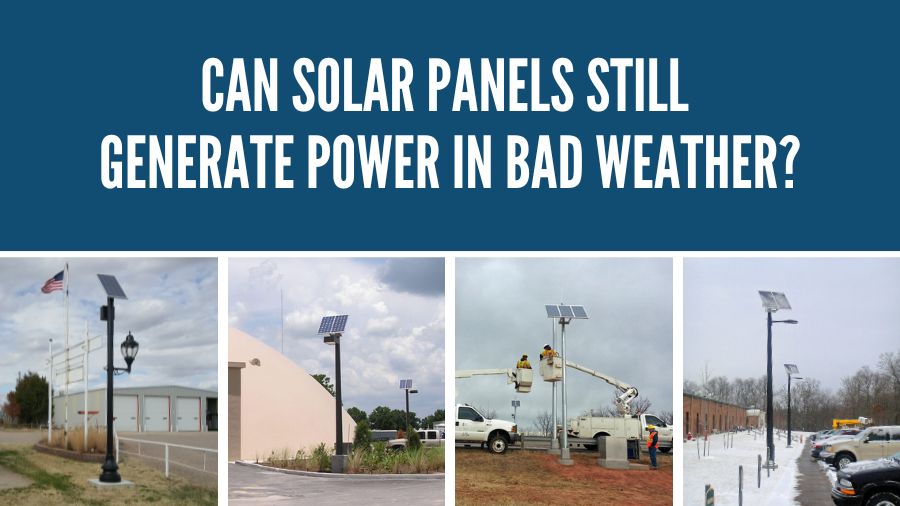


Even on the worst days, some UV rays and sunlight penetrate the clouds, allowing a solar panel to produce a charge, and even giving us a sunburn. Most people think solar will not work on a cloudy day, and I'm sure you can see how this is entirely incorrect. Let's quickly examine whether solar panels still generate power in bad weather.
Solar panels harness the energy from sunlight and convert it into electricity through the photovoltaic effect. This process relies on the interaction between photons (light particles) and semiconductor materials within the solar cells.
On cloudy days, even though direct sunlight is reduced, diffuse sunlight and UV rays still manage to reach the Earth's surface. This phenomenon is due to the scattering of sunlight by water droplets and particles in the atmosphere. While the intensity of this light is lower than direct sunlight, solar panels are designed to capture a broad spectrum of light, including these scattered rays.
The National Renewable Energy Laboratory (NREL) confirms that modern solar panels can generate approximately 10-25% of their rated capacity, even on cloudy days. This is a testament to the technology's ability to make use of available light to produce electricity.
Cloud cover impacts solar panels' energy output, but the reduction is not as severe as one might assume. The European Commission's Joint Research Centre conducted a study to assess the effect of cloud cover on solar energy production. Their findings revealed that solar panels can still produce about 25-40% of their potential energy outpu even on heavily cloudy dayst. This demonstrates that solar panels are far from dormant during overcast conditions.
The study attributes this continued energy generation to the ability of solar panels to capture not only direct sunlight but also diffuse sunlight and UV rays that manage to penetrate the cloud cover. This characteristic allows solar panels to remain productive even when the sky is overcast.
Diffuse sunlight results from sunlight scattering in various directions due to interactions with atmospheric particles. This type of sunlight lacks the concentrated intensity of direct sunlight but is still comprised of photons that solar panels can capture and convert into electricity.
Solar panels are equipped with cells sensitive to a broad light spectrum, including UV rays and scattered sunlight. This means that even when clouds block a significant portion of direct sunlight, solar panels can still absorb and convert a portion of the available light into usable energy.
The U.S. Department of Energy's Energy Education platform explains that while solar panels may not operate at their peak efficiency on cloudy days, they can still produce power by utilizing the scattered rays. This underscores the adaptability of solar panels to varying light conditions.
One of the most compelling examples of solar power generation on cloudy days comes from Germany. Despite its reputation for overcast skies, Germany has embraced solar energy and emerged as a global leader in its adoption. The country has invested heavily in solar infrastructure and policy support, enabling it to maximize solar power production even in less-than-ideal weather.
Germany's solar panels contribute significantly to the country's energy mix, even when the skies are cloudy. According to Clean Energy Wire, the consistent investment and commitment to solar energy have allowed Germany to showcase the technology's reliability in diverse weather conditions. This serves as a real-world testament to the viability of solar power on cloudy days.
Advancements in solar technology have played a pivotal role in enhancing energy generation on cloudy days. Traditional solar panels were primarily optimized for direct sunlight, which limited their efficiency during overcast conditions. However, modern panels are designed with improved light-capturing capabilities.
One notable advancement is bifacial technology, where solar panels are constructed to absorb sunlight from both the front and rear sides. This technology allows panels to capture reflected and diffuse sunlight, increasing overall energy yield. As a result, bifacial solar panels can generate more electricity under cloudy skies compared to their traditional counterparts.
SolarPower Europe highlights that bifacial solar panels have gained traction due to their ability to harness light from various angles, making them particularly effective on days with cloud cover. This technology represents a step forward in maximizing energy production regardless of weather conditions.
The misconception that solar panels are ineffective on cloudy days is disproven by scientific research and real-world examples. The ability of solar panels to capture diffuse sunlight, UV rays, and even scattered light through cloud cover allows them to maintain a meaningful level of energy production. As technology continues to evolve, solar panels are becoming even more efficient in converting available light into electricity, reinforcing their position as a sustainable energy solution regardless of the weather.
